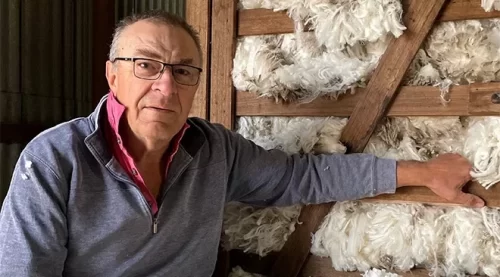
AWI chairman Jock Laurie.
AUSTRALIAN Wool Innovation and its supporters have stood firmly behind the levy-funded company’s marketing and promotion activities in two meetings with industry group representatives last week.
AWI directors and executives last week met with the Wool Industry Consultation Panel and the broader Woolgrower Consultation Group.
Meeting reports indicate AWI has marshalled support among most WCG and WICP members to ensure marketing and promotions spending remains a priority, despite recent analysis about its doubtful impact on grower wool prices, and the generally accepted expectation of lower levy income.
The meetings were told that the reduction in wool production — forecast to be 286mkg for 2024/25 — down 10 per cent on last year, and subdued prices means that AWI faces an annual budget reduction of around $11 million.
However, AWI chair Jock Laurie said the growers’ feedback from the meetings was that AWI should “focus on the things that are important to the industry”, rather than changing the current 60:40 marketing:R&D mix in levy expenditure.
“Defending the fibre overseas is critical, developing new markets is critical, maintaining profitability is critical.
“Basically what they were saying is we want you to make sure you are delivering, or that there is a commercial environment for us to continue to increase productivity on farm, and increase fleece value and increase profitability,” he said.
“But at the same time, we want you to develop markets and defend our right to operate.
“So what they have said is, it’s not necessarily about a 60:40 split, that’s there at the moment and that seems to be and the argument is it could be worked the other way,” Mr Laurie said.
“We’ve got people who want to go all marketing, we’ve got people who want to go all research, but I think the general consensus is in that barrier there – somewhere 60:40 50:50 – they are basically saying to the board is here are all the things that we’ve identified as important to the industry,” Mr Laurie said.
According to AWI, a brief statement on the meeting of the nine-industry member Wool Industry Consultation Panel said among the industry priorities highlighted were: marketing and research programs to maintain and defend wool’s reputation and drive growth, research and extension, shearer and shed hand training, and domestic engagement.
AWI management and board value the input and this will underpin work for the development of the next strategic plan which will cover the period from July one 2025 for three years, the report said.
All current programs are important
A report on the WCG meeting by facilitator Scott Williams said “the overall message from the WCG to AWI was that all of its current programs are important and need to be continued as far as possible,” Mr Williams reported.
“The WCG asked that AWI management, and the board identify opportunities to make efficiency savings, to maximise leverage of AWI funds, and to defer expenditure or put projects on hold where possible until financial conditions improve.
“It was agreed that it is up to the AWI board to determine the appropriate mix of activities it undertakes, in the best interests of wool growers, while meeting its financial responsibilities.”
Mr Williams said the WCG noted that all industry groups, including those represented on the WCG, must do more to bolster confidence and to connect AWI and wool growers.
“This includes communicating the benefits of sheep in farm systems, activities that AWI undertakes on behalf of growers, and the results of R&D.”
The WCG report said shearer/shedhand training continues to be important, but could be more targeted to regions of greatest need. Other productivity initiatives also remain important, but R&D must be prioritised to deliver the greatest impact. Extension must also be focused on areas of highest importance.
The WCG report said AWI’s activities to defend wool, particularly in the EU, are vitally important and must be continued.
“Finding new products and new markets for wool should also continue to be priorities for AWI.”
Suggestions of cost-cutting included fewer ‘Beyond The Bale’ editions and reducing expenditure on AWI’s industry consultation, by holding an WCG meeting online.
The WCG report said there was a presentation on a report commissioned by WoolProducers Australia on the effect of marketing expenditure on wool price.
Mr Williams reported that AWI chair Jock Laurie assured the WCG that AWI always obtains the maximum available quantum of government matching funds for R&D investment, but this is capped at 0.5 percent of the industry gross value of production. The meeting asked AWI to consider how the effectiveness of its marketing expenditure could be better communicated to growers.
When Sheep Central asked Mr Laurie whether AWI had the full support of industry to maintain its marketing promotion and research and development programs, he said it was good to talk to committed industry people and explain personally what AWI was doing and why, and where the groups’ priorities were and if anything else should be done.
“I think that what came out of it is that the vast majority of the things that the company is doing are supported by the industry – there are not too many outliers sitting out there that we haven’t focussed on.”
He said it is important that growers have all the tools available to them to maximise profit per sheep, but he said this was not contradictory to continuing marketing programs that might have little impact on growers’ wool prices.
Mr Laurie did not support the contention that expenditure on marketing should increase wool prices. He said all growers at the meetings supported AWI continuing its work in labelling and protecting wool through Product Environmental Footprint legislation. They also supported AWI continuing to develop new markets for wool.
“Now will that be reflected in price and demand – I think there is general acceptance across the board, everybody knows that economic circumstances drive price.
“We’ve known that for years, we get that economic analysis every meeting.”
But when asked whether this supported putting less money into marketing and more into on-farm R&D to reduce farmers costs of production, Mr Laurie said the consultation groups members felt there were already commercials tools to do that. But he said there was still a need to identify tools from Sheep Genetics and the Merino Lifetime Productivity Project to complement that.
“There is no point this company doing things that the growers don’t want.
“It’s really important that we engage in things that they think important to them,” he said.
Mr Laurie said AWI would not include a wool price metric for assessing potential marketing campaigns, but would consider any economic conditions or movements in markets being targeted to “have a better opportunity of success.” When asked if it was unfair for growers to expect that AWI programs are based on whether they will have an impact on their bottomlines or wool prices, Mr Laurie said:
“I think we’ve got to be honest, I don’t know that any marketer around the world will tell you that the more money I’ve spent on marketing, the more it will increase the price of the product I’m marketing.
“It think what they are trying to do is to get access into markets, keep the product they’re buying relevant,” he said.
The WCG report said there was a presentation on a report commissioned by WoolProducers Australia on the effect of marketing expenditure on wool price. The Episode 3 report found that AWI’s wool marketing spend did not have a meaningful impact on the wool price benchmark – AWEX’s Eastern Market Indicator.
Mr Laurie said the AWI board received a lot of the material referred to in the WoolProducers report at every meeting. He said AWI analysed the economic factors in each of the markets that wool was sold into.
“The WoolProducers report confirmed a lot of the stuff that we get regularly.”

Maybe AWI should have spent more money assisting producers in how to end mulesing. South Africa has a huge premium to Australian wool because that.
That would have been a better spend to help with ‘marketing’.
That would seem a mistake.
Haven’t they got the message?
More perks and less work in that.